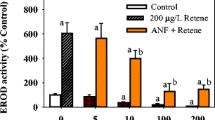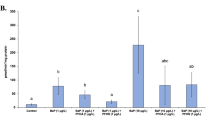Abstract
Despite ubiquity of polycyclic aromatic hydrocarbons (PAHs) in the tropical environments, little information is available concerning responses of tropical fish to PAHs and associated toxicity. In the present study, effects of five PAHs containing two to four aromatic rings on hepatic CYP1A dependent ethoxyresorufin O-deethylase (EROD), glutathione S-transferase (GST) and serum sorbitol dehydrogenase (SDH) activities in Nile tilapia, a potential fish species for biomonitoring pollution in tropical waters, were evaluated. Results showed that EROD activities were induced by the PAHs containing four aromatic rings (pyrene and chrysene) in a dose dependent manner. However PAHs with two to three aromatic rings (naphthalene, phenanthrene and fluoranthene) caused no effect or inhibition of EROD activities depending on the dose and the duration. Fluoranthene was the most potent inhibitor. SDH results demonstrated that high doses of fluoranthene induced hepatic damage. GST activity was induced by the lowest dose of phenanthrene, fluoranthene and chrysene but high doses had no effect. The results indicate that induction of EROD enzyme in Nile tilapia is a useful biomarker of exposure to PAHs such as pyrene and chrysene. However EROD inhibiting PAHs such as fluoranthene in the natural environment may modulate the EROD inducing potential of other PAHs thereby influencing PAH exposure assessments.


Similar content being viewed by others
References
Basu N, Billard S, Fragoso N, Omoike A, Tabash S, Brown S, Hodson P (2001) Ethoxyresorufin-O-deethylase induction in trout exposed to mixtures of polycyclic aromatic hydrocarbons. Environ Toxicol Chem 20:1244–1251
Behrens A, Schirmer K, Bols KNC, Segner H (2001) Polycyclic aromatic hydrocarbons as inducers of cytochrome activity in the rainbow trout liver cell line, RTL-W1 and in primary cultures of rainbow trout hepatocytes. Environ Toxicol Chem 20:632–643
Billard SM, Bols NC, Hodson PV (2004) In vitro and in vivo comparisons of fish specific CYP1A induction relative potency factors for selected polycyclic aromatic hydrocarbons. Ecotoxicol Environ Saf 59:292–299
Bosveld ATC, de Bie PAF, van den Brink NW, Jongepier H, Klomp AV (2002) In vitro EROD induction equivalency factors for the 10 PAHs generally monitored in risk assessment studies in The Netherlands. Chemosphere 49:75–83
Burke MD, Mayer RT (1974) Ethoxyresorufin: direct fluorometric assay of a microsomal O-deethylation which is preferentially inducible by 3-methylcholanthrene. Drug Metab Dispos 2:583–588
Fent K, Batscher R (2000) Cytochrome P4501A induction potencies of polycyclic aromatic hydrocarbons in a fish hepatoma cell line: demonstration of additive interactions. Environ Toxicol Chem 19(8):2047–2058
George SG (1994) Enzymology and molecular biology of phase II xenobiotic conjugating enzymes in fish. In: Malins DC, Ostrander GK (eds) Aquatic toxicology: molecular, biochemical and cellular perspectives. Lewis Publishers, CRC press, Boca Raton, pp 37–85
Gerlach U (1983) Sorbitol dehydrogenase. In: Bergmeyer HU (ed) Methods of enzymatic analysis. Verlag Chemie, Weinheim, pp 112–117
Gold-Bouchot G, Zapta-Perez O, Rodriguez-Fuentes G, Ceja-Moreno V, Rio-Garcia MD, Chzan-Cocom E (2006) Biomarkers and pollutants in the Nile tilapia, Oreochromis niloticus, in four lakes from San Miguel, Chiapa, Mexico. Int J Environ Pollut 26(123):130–141
Habig WH, Pabst MJ, Jakoby WB (1974) Glutathione S-transferases. The first enzymatic step in mercapturic acid formation. J Biol Chem 249:7130–7139
Hylland K (2006) Polycyclic aromatic hydrocarbon (PAH) ecotoxicology in marine ecosystems. J Toxicol Environ Health A 69:109–123
Lee RF, Anderson JW (2005) Significance of cytochrome P450 system responses and levels of bile fluorescent aromatic compounds in marine wildlife following oil spills. Mar Pollut Bull 50:705–723
Lowry H, Rosebrough NJ, Farr AL, Randall RJ (1951) Protein measurement with the folin phenol reagent. J Biol Chem 193:265–275
Lu GH, Wang C, Zhu Z (2009) The dose-response relationships for EROD and GST induced by polyaromatic hydrocarbons in Carassius auratus. Bull Environ Contam Toxicol 82(2):194–199
McElroy AE, Farrington JW, Teal JM (1989) Bioavailability of polycyclic aromatic hydrocarbons in the aquatic environment. In: Varanasi U (ed) Metabolism of polycyclic aromatic hydrocarbons in the aquatic environment. CRC press, Boca Raton, pp 1–40
Oliveira M, Pacheco M, Santos MA (2007) Cytochrome P4501A, genotoxic and stress responses in golden grey mullet (Liza aurata) following short term exposure to phenanthrene. Chemosphere 66:1284–1291
Pathiratne A, George SG (1998) Toxicity of malathion to Nile tilapia, Oreochromis niloticus and modulation by other environmental contaminants. Aquat Toxicol 43:261–271
Pathiratne A, Chandrasekera LWHU, Pathiratne KAS (2009) Use of biomarkers in Nile tilapia (Oreochromis niloticus) to assess the impacts of pollution in Bolgoda Lake, an urban water body in Sri Lanka. Environ Monit Assess 156:361–375
Srogi K (2007) Monitoring of environmental exposure to polycyclic aromatic hydrocarbons: a review. Environ Chem Lett 5:169–195
Teles M, Pacheco M, Santos MA (2003) Angilla anguilla L. liver ethoxyresorufin O-deethylation, glutathione S-transferase, erythrocytic nuclear abnormalities and endocrine responses to naphthalene and β-naphthoflavone. Ecotoxicol Environ Saf 55:98–107
Till M, Riebniger D, Schmitz HJ, Schrenk D (1999) Potency of various polycyclic aromatic hydrocarbons as inducers of CYP1A in rat hepatocyte cultures. Chem Biol Interact 117(2):135–150
Timme-Laragy AR, Cockman CJ, Matson CW, Di Giulio RT (2007) Synergistic induction of AHR regulated genes in developmental toxicity from co-exposure to two model PAHs in zebrafish. Aquat Toxicol 85:241–250
van der Oost R, Beyer J, Vermeulan NPE (2003) Fish bioaccumulation and biomarkers in environmental risk assessment: a review. Environ Toxicol Pharmacol 13:57–149
Whyte JJ, Jung RE, Schmitt CJ, Tillitt DE (2000) Ethoxyresorufin-O-deethylase (EROD) activity in fish as a biomarker of chemical exposure. Crit Rev Toxicol 30:347–570
Willett KL, Wassenberg D, Lienesch L, Reichert W, Di Giulio RT (2001) In vivo and in vitro inhibition of CYP1A-dependent activity in Fundulus heteroclitus by the polynuclear aromatic hydrocarbon fluoranthene. Toxicol Appl Pharmacol 177:264–271
Zapata-Perez O, Gold-Bouchot G, Ortega A, Lopez T, Albores A (2002) Effect of pyrene on hepatic cytochrome P450 1A (CYP1A) expression in Nile tilapia, (Oreochromis niloticus). Arch Environ Contam Toxicol 42:477–485
Zar JH (1999) Biostatistical analysis. Prentice Hall, Upper Saddle River, NJ
Acknowledgements
This study was financially supported by a research grant from National Research Council of Sri Lanka (Grant number 05-24). The second author was financially supported by National Science Foundation of Sri Lanka (Grant number RG/2006/EB/07) in the form of a research assistantship.
Author information
Authors and Affiliations
Corresponding author
Rights and permissions
About this article
Cite this article
Pathiratne, A., Hemachandra, C.K. Modulation of ethoxyresorufin O-deethylase and glutathione S-transferase activities in Nile tilapia (Oreochromis niloticus) by polycyclic aromatic hydrocarbons containing two to four rings: implications in biomonitoring aquatic pollution. Ecotoxicology 19, 1012–1018 (2010). https://doi.org/10.1007/s10646-010-0482-3
Accepted:
Published:
Issue Date:
DOI: https://doi.org/10.1007/s10646-010-0482-3




